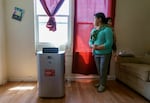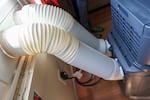Portland could see record breaking temperatures over the weekend, with weather conditions similar to the deadly heat dome event in 2021.
That extreme weather, which killed 69 people in Multnomah County, brought heat to the forefront of the climate crisis in the region and prompted swift action from city and local organizations that promised to help residents adapt. While those efforts have had some success nearly two years later, some say more needs to be done.
Starting Friday, the Portland metro could see temperatures rising into the 90s, prompting the National Weather Service to issue an excessive heat watch through Monday. NWS meteorologist Daniel Hartsock said the increase in temperature is coming from a high-pressure system like the heat dome event that trapped hot air over the region in June 2021. He said the same system is also creating offshore easterly winds, which add to dry conditions.
Hartsock said the average high is typically around 70 degrees in mid-May.
“We’re looking at temperatures 20 to 25 degrees above normal, so that’s definitely not very common,” he said.
According to historic data, the region has reached 90 degrees in the first half of May just eight times since records have been kept at the Portland International Office. Hartsock said the last time there were three consecutive 90 degree days in the first half of May was 1987.
“It’s fairly rare,” he said.
Heat pumps rolling out
As the world continues to burn the coal, oil and natural gas that’s driving human-caused climate change, local governments and agencies are doing more to adapt to the resulting extreme weather. Oregon is already experiencing hotter summers, which according to scientists will only get worse over time if we don’t reduce greenhouse gas emissions.
In response to the 2021 deaths, state, city and local organizations began to distribute air conditioning units and heat pumps, as well as offer more cooling centers during extreme heat.

Juana Pascual Pascual (cq), holds her child Frankie Gaspar, 2, at their second-floor Portland apartment where they have lived for six years. She said her family suffered during last year’s heat dome, with just bottled water to find relief. On Monday, June 27, 2022, she received a free cooling/heating unit through the Portland Clean Energy Fund working with Verde.
Kristyna Wentz-Graff / OPB
The Portland Clean Energy Fund, a tax-funded grant program to fight climate change and social inequities, created a heat response program now called Cooling Portland. The program installs portable AC units or heat pumps for Portlanders whose income is less than 60% of the median income household and who are either living alone, elderly or have medical conditions that are more vulnerable to heat.
The program’s goal is to install 15,000 units by 2026. In its first year, the program distributed more than 3,000 units. This year, their goal is 4,000.
PCEF spokesperson Elizabeth Stover said despite being ahead of their long-term goal, they need to install units faster.
“We’ve opened an application process to onboard additional community-based organizations and housing providers this year, which will increase capacity within the program,” she said.
Stover said about 46% of the program’s installations occurred in homes east of 82nd Avenue, a section of the city that is highly vulnerable to heat, according to a new Multnomah county heat map. The map uses three key factors to assess heat vulnerability: sensitivity to heat and illness, exposure to extreme heat and capacity to adapt.
Earth Advantage was selected to purchase and distribute units to partners who then install them in homes. According to the organization, 273 units have been distributed so far this year.
Local environmental organization Verde was one of the first groups distributing portable heat pumps after receiving a grant from the clean energy fund.
Verde’s Ricardo Moreno, who runs the program, said the organization was able to install about 450 units last year.

Heat pumps can work for both heating and cooling. You can think of a heat pump as an air conditioner that can also work backwards.
Julia Simon / NPR
“We would have done more but that’s all the units that they had in the first year available to us,” he said. “We are the only organization that has been installing these units year-round.”
Moreno said Verde recently received funding to begin their second year with the program. The goal is to install 690 units this year. He said in the first year, Verde received more than 1,000 applications from residents.
“The need is big and I’m expecting hundreds more in the next couple of weeks,” he said. “After this heatwave is when people start really getting concerned, and I’m sure we’ll get many, many more calls.”
Moreno said the heat pumps only offer a temporary solution. Many households are grateful to receive these units after going through hot summer without any relief, but he said the portable units can only cool a small section of a home. He’d like to see more options for renters and incentives so people can purchase heat pumps on their own.
“These portable units are kinda like a band aid to the problem,” he said. “It’s a super temporary solution. It works, but it’s not a long-term solution.”
Moreno suggested creating incentives to install mini-split heat pumps, which work throughout the home and allow you to control the temperature in different spaces. Another suggestion is installing ductless heat pumps, which require no vents throughout the home to deliver air – something Verde has been doing since 2019.

A cooling/heating unit installed in a Portland home on June 27, 2022, provided by the Portland Clean Energy Fund working with Verde. The units at Verde are available to people over 60, with a medical condition that can be affected by heat, and/or live alone.
Kristyna Wentz-Graff / OPB
Oregon lawmakers are also currently debating Senate Bill 868, which would create a goal of installing 500,000 heat pumps across the state by 2030. The bill would create financial incentive programs using state and federal funds from the Inflation Reduction Act, as well as programs like the Portland Clean Energy Fund.
More research and coordination needed
Vivek Shandas, a professor of climate adaptation at Portland State University, agrees that Oregon needs more significant changes to survive future heat events. He said there needs to be more focus on what systems or programs are effective in different areas. The solutions may look different in public housing, single-family homes, multi-dwelling residences or commercial development.
Shandas said recent research found that even though some residents had an air conditioner or heat pump in their homes, the units still didn’t provide enough relief when needed. He said some units aren’t powerful enough, with some homes still reaching above 80 degrees.
“When we throw a lot of air conditioning units or heat pumps at the heat challenge, this really indicates that, you know, we may be creating other implications,” he said.
Those other implications are, for example, the effect all these units are having on the power grid, Shandas said.
Shandas said one solution could be hiring a chief heat officer, a person who addresses the effects of extreme heat and figures out ways to adapt. Only three U.S cities have chief heat officers — Miami, Phoenix and Los Angeles.
He said a heat officer would help with communication and coordination between city and local organizations to quickly find what works.
Short of a heat tsar, a combined department could help Portland and Multnomah County coordinate.
“So, getting a municipal entity like that to help coordinate the multiple aspects of this work I think would be really worthwhile for people to know about,” he said.
Shandas, who’s lived in the Pacific Northwest for more than 25 years, said despite the devastating and deadly effects of the 2021 heat dome, it “unequivocally” shifted people’s perspectives on the realities of climate change in the region, leading to more focus on solutions.



